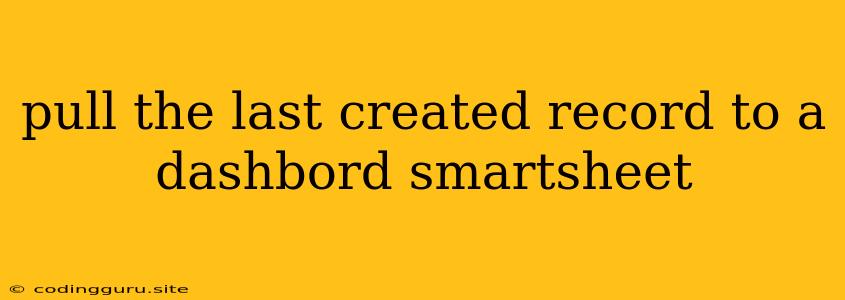Pulling the Last Created Record to a Smartsheet Dashboard: A Step-by-Step Guide
In the dynamic world of data management, keeping track of the latest updates is crucial. For many, Smartsheet serves as a central hub for organizing and visualizing information. But how do you ensure your dashboard always displays the most recent data, specifically the last created record? This article will guide you through the process of pulling the last created record to your Smartsheet dashboard.
Understanding the Challenge
Smartsheet's powerful automation features can be leveraged to fetch the latest data. However, the challenge lies in identifying and isolating the most recently created record. Directly pulling the "last created" record from a Smartsheet sheet isn't a standard feature. You'll need a clever work-around using a combination of Smartsheet formulas and automation.
Utilizing Smartsheet Formula Power
The key to finding the last created record lies in leveraging the "Last Modified" column within your Smartsheet sheet. This column automatically tracks the date and time of the last edit. By identifying the record with the latest "Last Modified" timestamp, you've essentially found your "last created" record.
Step 1: Analyze Your Data
- Data Structure: Examine the structure of your Smartsheet sheet. Each column represents a specific data point, and each row represents a unique record.
- Identifying Columns: Focus on the columns you need to display on your dashboard. These might include "Name," "Description," "Date Created," or other relevant information.
Step 2: Leverage the "Last Modified" Column
- Create a Formula: In a new column within your Smartsheet sheet, use the following formula:
=MAX(SheetName[Last Modified]). Replace "SheetName" with the actual name of your Smartsheet sheet. This formula determines the latest "Last Modified" timestamp across all records. - Compare and Filter: Create another formula to compare the "Last Modified" timestamp of each individual record with the maximum timestamp identified in the previous step. This will allow you to filter the sheet and display only the record with the most recent "Last Modified" timestamp.
Step 3: Bringing the Data to Your Dashboard
Now, you have the "Last Created" record isolated. Here's how to bring it to your dashboard:
- Smartsheet Reports: Use Smartsheet's report builder to create a report that pulls data from your sheet. Configure the report to only include the record with the most recent "Last Modified" timestamp. This report can be embedded directly onto your dashboard.
- Automations: Smartsheet's automation features can further streamline the process. Set up an automation rule that automatically updates the dashboard whenever a new record is created on the sheet, pulling in the latest "Last Created" record data.
Example: Tracking Project Updates
Let's imagine you manage a project with multiple tasks in a Smartsheet sheet. Each row represents a task, and the "Last Modified" column tracks when a task's details were updated.
- Create a new column called "Last Modified Max" in your Smartsheet sheet. Apply the formula:
=MAX(SheetName[Last Modified])to this column. It will display the latest "Last Modified" timestamp across all tasks. - Create another column called "Latest Task" and use the formula:
=IF(SheetName[Last Modified]=SheetName[Last Modified Max], 1, 0). This formula compares the "Last Modified" timestamp of each individual task with the "Last Modified Max" value. If they match, it returns a "1," indicating that the task is the most recently updated. - Create a Smartsheet report that only pulls data from rows where "Latest Task" is equal to "1". This report will only include the details of the most recently modified task.
- Embed this report onto your dashboard. Now, you have a dynamic view of the latest project update!
Tips for Success
- Data Integrity: Ensure that your Smartsheet sheet's "Last Modified" column accurately reflects the creation timestamps of your records. If you modify records after creation, it might affect your results.
- Regular Updates: Configure your dashboard to update automatically on a periodic basis. This ensures your dashboard always displays the most current "Last Created" record.
- Advanced Automation: Explore Smartsheet's advanced automation features to create custom workflows and triggers that keep your dashboard synchronized with your sheet's latest data.
Conclusion
Pulling the last created record to a Smartsheet dashboard can be achieved by creatively using Smartsheet formulas and automation. By leveraging the "Last Modified" column and applying appropriate logic, you can efficiently identify and display the most recent record, ensuring your dashboard always reflects the latest updates.
